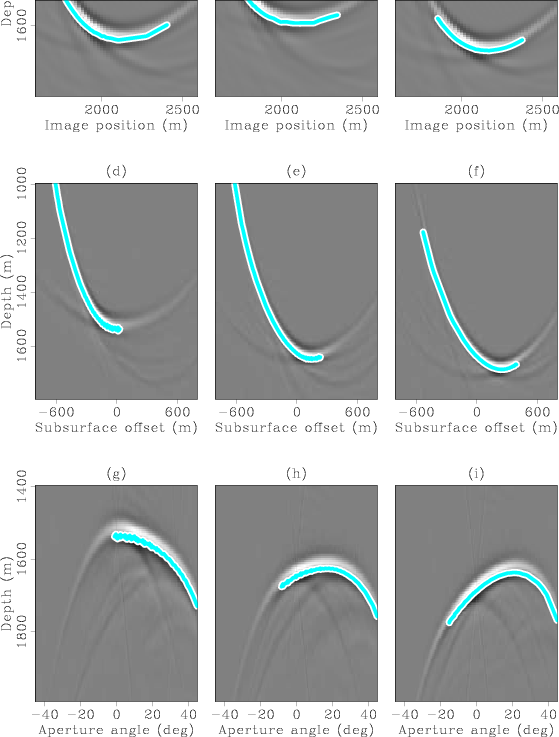Next: Radon Transform
Up: Kinematics of 2D multiples
Previous: Specular multiple from dipping
The diffracted multiple has very different characteristics compared to the specular
multiple. The residual moveout equations are very involved and were presented
in (). Figure 6 is a
summary of the mapping of this multiple to image space for a diffracted multiple
sitting on a dipping water-bottom. The top three panels correspond to subsurface
offset sections taken at 0, -200 and 200 m (panels (a) to (c) respectively).
Notice that the moveout of the multiples looks like migration ``smiles'' which
is one of the tell-tale indications of diffracted multiples on a migrated angle
stack. The middle panels in Figure 6 correspond to
SODCIGs taken at lateral positions 1800, 2000 and 2200 m. The diffractor is located
at 2000 m and the offsets are positive towards increasing lateral positions. This
causes the bottom of the moveout curve to shift away from zero as the SODCIG is
taken away from then location of the diffractor (compare panels (b) and (c), for
example). Panel (b) corresponds to the location of the diffractor and therefore its
bottom is at zero subsurface offset. Finally, the bottom panels are the ADCIGs of
the corresponding SODCIGs in the middle panels. Notice that again, the apex of
the moveout curve moves away from zero aperture angle as the ADCIG is taken at
locations not directly above the diffractor. In all the figures the solid lines
are the moveout curves computed with the equations in ().

|
|---|
diffmul-dip-moveout
Figure 6. Diffracted multiple from dipping water-bottom.
Top panels are subsurface offset sections taken at 0, -200 and 200 m (from (a) to (c)).
The middle panels are SODCIGs taken at 1800, 2000 and 2200 m horizontal location
(panels (d) to (f)). The diffractor is at 2000 m. Bottom panels are the ADCIGs
corresponding to the SODCIGs of the middle panels. The solid lines are the moveout
curves computed with the equations given by ().
|
|---|
![[pdf]](icons/pdf.png) ![[png]](icons/viewmag.png)
|
|---|
Next: Radon Transform
Up: Kinematics of 2D multiples
Previous: Specular multiple from dipping
2007-10-24
